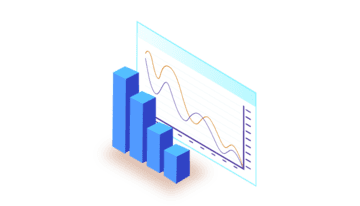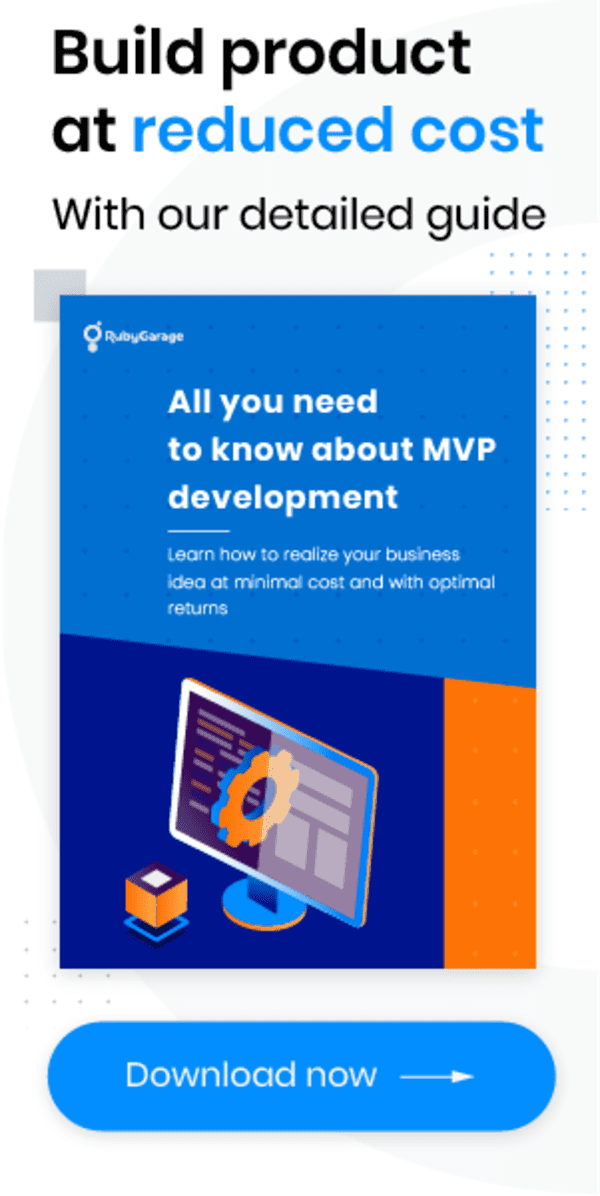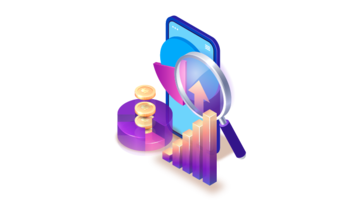-
Product Management
Software Testing
Technology Consulting
-
Multi-Vendor Marketplace
Online StoreCreate an online store with unique design and features at minimal cost using our MarketAge solutionCustom MarketplaceGet a unique, scalable, and cost-effective online marketplace with minimum time to marketTelemedicine SoftwareGet a cost-efficient, HIPAA-compliant telemedicine solution tailored to your facility's requirementsChat AppGet a customizable chat solution to connect users across multiple apps and platformsCustom Booking SystemImprove your business operations and expand to new markets with our appointment booking solutionVideo ConferencingAdjust our video conferencing solution for your business needsFor EnterpriseScale, automate, and improve business processes in your enterprise with our custom software solutionsFor StartupsTurn your startup ideas into viable, value-driven, and commercially successful software solutions -
-
- Case Studies
- Blog
How to Validate a Product: A Guide for Successful Product Validation
Product validation minimizes the risk of wasting resources on developing the wrong product. It helps you ensure that your product will be in demand, bring the expected revenue, and gain a competitive advantage. In this post you’ll find the answers to the questions:
- How to estimate potential revenue from the product?
- How to find out what your users want and need?
- How to ensure your competitive advantage?
This article takes you through all the steps of product validation to avoid wasting resources and ensure your product’s success.
What is product validation?
When you come up with a new idea, you have no clue if it will find its audience and become popular. You have only a hypothesis based on some assumptions. Such ideas are always risky. Here are examples of what you can face:
- Poor product–market fit. Your product may not find demand in the chosen market. Or you may identify the right market but address the wrong needs.
- No competitive advantage. Without a unique value proposition, you can face stiff competition or get lost among thousands of similar services.
- Misinvesting. You might spend more resources than you intended or even run out of money developing an infeasible product.
But don’t give up yet. There’s a way to minimize your risk of failure and enhance your idea.
Product validation helps you estimate market interest in your product and avoid developing a product that lacks demand. It entails researching, gathering and analyzing data as well as testing your product.
Your research can be quantitative, focusing on numbers and assessing the big picture, such as the size of the market or the number of interested users. Or it can be qualitative, focusing on reasons and opinions and giving an idea of problems users face and goals they’d like to achieve.
You can achieve the best results by combining quantitative and qualitative research, which is why we’ll pay attention to both in our guide.
Why new product validation matters
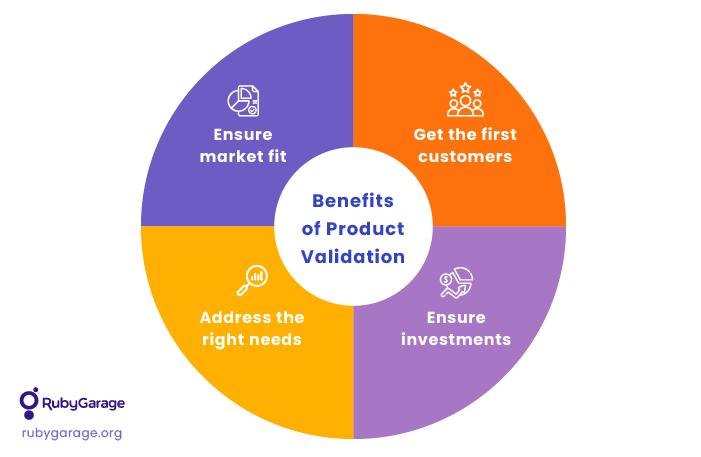
- Ensure there’s market demand for the product. 35% of all startups fail because of poor product–market fit. New product validation helps you ensure that your product is needed, that there’s an interested market, and that it has enough value to gain a competitive advantage.
- Define and address customers’ needs. The more you know about your customers and the problems they face, the easier it is for you to solve those problems. While testing your idea, you may come up with some features you hadn’t thought of or slightly change direction to better fit the market. Product validation helps you ensure that your product brings value to customers.
- Get your first customers. During research, you communicate with your target audience. They might become interested in your product and become your future customers.
- Secure your investments. Without a clear strategy and feature set, a project requires many adjustments at every step and risks being unneeded by users. Product validation lets you invest in a product after it has proven viable and potentially profitable.
There are lots of opinions on how to validate a product. We’ve gathered and analyzed them all in this step-by-step guide to new product validation.
Step 1. Prepare
Before you start your research, you’ll need to get some data to determine what you need to research. Gathering the team who will be responsible for thorough research is also a must when getting ready for product validation.
Define an optimal team
Product validation is not a task for one person. A team of professionals can help you conduct proper research and avoid personal biases. Let’s look at whom to involve in validating your new product.
Identify external stakeholders
When your product is not independent, you must consider stakeholders. Think of all the factors that influence your product in advance and consider them while creating a new product. These factors can be media, communities, governments, trade unions, or other entities.
For example, you might need to comply with the Web Content Accessibility Guidelines, which stipulate that there must be accessible versions of government and public websites. These guidelines are required by law in the USA, Canada, the European Union, and other jurisdictions. All medical software for the US market must be HIPAA compliant, which means that patient information should be protected from fraud and disclosure. You can’t develop a successful product without addressing all compliance requirements.
List all requirements your product must comply with to make sure you follow them at every step of product development.
Gather your internal team
Involving a domain expert can also help with product validation. Usually, startuppers don’t have all the expertise and experience necessary for validating a new product.
Returning to the HIPAA example, you might not know what rules you need to follow and where to find them. Sometimes, you might not even know that requirements exist. A domain expert can provide all necessary information and ensure your website complies with all requirements.
Experts help you get a better understanding of the market, which is crucial in decision-making when developing a new product.
Technical specialists can help you validate all the information you gather during your research and ensure your product’s feasibility. The specialists involved and their tasks will differ depending on what you need to accomplish, but your team should generally include:
- A product or project manager to facilitate the work of the whole team
- A business analyst to collect requirements and set research tasks, carry out the research, create a business model, and form a unique value proposition
- UI/UX designers to carry out UX research and create an MVP prototype
- Developers to validate the product’s technical feasibility and develop MVP functionality
- QA engineers to test the MVP functionality
Each team member has their expertise and area of responsibility. This increases risk coverage. Moreover, a diverse team ensures an objective view of the product that isn’t guided by personal cognitive biases.
There are many specialists involved in validating a software product, so it can be time-consuming to gather the team. The good news is that you can choose who will conduct your product validation. You might hire an in-house team or outsource the task. In the table below, we compare both options.
|
Team |
In-house |
Outsourcing |
|---|---|---|
|
Characteristics |
|
|
|
Where to find |
Must hire each employee separately through platforms: |
Can find outsourcing companies through ratings and review platforms: |
Estimate the market
Before reaching the market, you have to determine its size — the number of your potential customers and the total revenue they can bring. This helps with financial planning and forecasting.
Here, we deal with three main concepts: total addressable market (TAM), served addressable market (SAM), and share of market (SOM). Let’s look closer.

TAM indicates the total size of the market in a particular industry: the insurance market, ecommerce market, software development market, and so on. This value is the estimated whole market turnover. For example, TAM in the insurance industry in 2020 was equal to about $1.28 trillion.
SAM is the part of the market you theoretically can serve, taking into account your geographical location and service specialization. Taking the insurance example, let’s assume you provide only life/annuity insurance in a few states. Only a certain percentage of the total market (48.9%) could possibly benefit from your service. Still, not all customers in the market can reach you due to geographic limitations. Thus, your SAM will be even smaller than 48.9% of the total market.
SOM is the part of SAM that will finally become your customers. Not all people you can serve will actually want your services, which is why SOM is even smaller than SAM. SOM is affected by:
- the number of competitors and their market shares — a certain percentage of the market is already taken
- resource limitations — your processes might not allow you to serve all the SAM
- market awareness — the audience should know your product exists
- pricing — your product might be too expensive for some part of the market
To find out the TAM and SAM values for your product, you have to either perform thorough market research or look for ready statistics. Research might be expensive and time-consuming, which is why most startups buy statistics from companies such as MarketResearch or Statista, or find free sources of information like Statcounter and Eurostat
As for SOM, this value cannot be accurately estimated for new businesses, but you can make a guess by considering your SAM, competitors, resources, pricing, and market awareness.
After conducting research, analyze your findings and decide if you’re still interested in entering the market. Make sure there’s enough market potential to cover your investments and bring you profit.
Data gathered during market estimation is quantitative and helps you not only with validating your product but also when attracting investors, as nothing persuades more than numbers.
Build a buyer persona
Before you start research, you have to understand your product’s target audience. You need to know who is going to use the product to create the right research strategy and select relevant respondents for further interviewing and product testing.
Describe a typical user of your product:
- Who they are: location, age, gender, education, occupation, skills
- What motivates them: problem to solve, objectives, obstacles, result to achieve
- Why they need the product: reasons, expectations
- How they found you: search methods, selection criteria, decision motivation
Listing all the user characteristics above helps you define a typical representative of your target audience so you know better what product will fit their needs.
Create your business model hypothesis
Before you start research, you need to document your business idea so you can refer to it and so every stakeholder knows what they’re working on. Here’s a guide on how to design a business model. But creating a business plan might be time-consuming and require a lot of data. So as not to waste time, there’s an easy way for startups to document hypotheses — with a lean canvas.
This approach allows you to summarize all your ideas using one convenient template. Thus, you can adjust your business model during research with little time and effort, staying focused on the main goal and not getting overloaded with details.
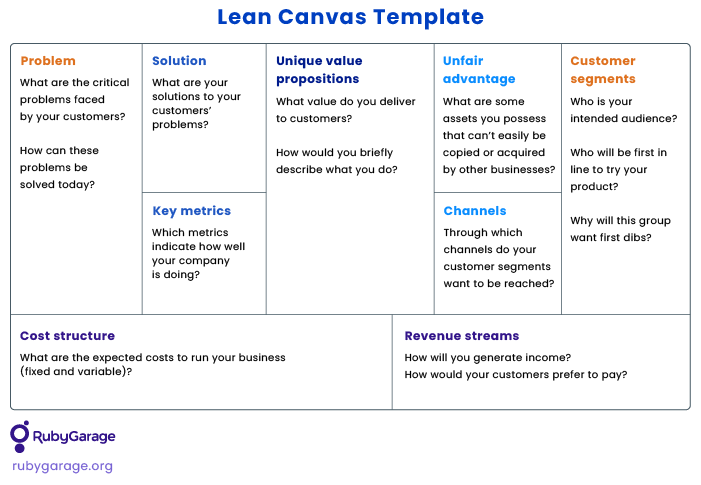
Step 2. Research
One of the most critical questions about any idea is whether the problem you want to fix really exists. You have to ensure your solution is valuable for the audience. To determine this, according to Steve Blank, you have to get out of the building and explore your users.
Talking to your audience will help you validate your product. You’ll find out either that your idea is worthy or that no one is interested in it. In either case, you’ll get even more insights for developing a successful product.
Make sure you can build your product, define your typical users, research competitors, and find the best solutions. All this information helps you estimate whether your product will meet demand and bring you the expected revenue.
Feasibility study
The first and most crucial check when validating a new product is to make sure you’re able to create it. You must have the right team and tech stack to develop your product, ensure you have sufficient financing, and wisely allocate your resources.
For example, say your idea relies on artificial intelligence. Then you must be a specialist in this technology or have enough money to hire someone who is.
When conducting a feasibility study, pay attention to several points:
- Technical feasibility: Can you build and maintain the product? Do you have all the necessary technologies and specialists?
- Economic feasibility: Do you have enough resources to bring your idea to life? Will the project’s probable revenue ensure a return on investment?
- Legal feasibility: Does your product comply with all applicable laws, regulations, and standards?
- Operational feasibility: Does the product meet market needs and serve the business?
- Scheduling feasibility: Have you set achievable deadlines and chosen the right time to launch?
To make sure your product is feasible in all these respects, perform a feasibility study. You can find more details about how to conduct a study in our feasibility study guide.
Surveys
The easiest way to learn more about your target audience is to ask questions. You can do this on the internet via your website or a social media page, or you can find people to answer questions through advertisements.
Conducting surveys helps you get all the data you need. But make sure your questions are clear and refer directly to the idea you’re studying. Avoid long and difficult surveys so as not to scare away the audience.
In the image below, you can see the types of questions to ask.

To easily find respondents for surveys and conduct them conveniently, you can use services like Pollfish, SurveyMonkey, and Google Surveys.
From surveys, you can find out whether your product is interesting, whether people see it as having direct substitutes, and whether people would potentially buy it. You can think of more specific questions about your product and gather your users’ opinions about it.
One more advantage of conducting surveys is that you can collect the emails of your respondents and start building a database of potential users.
Interviews and focus groups
Try to involve your audience in an interview. Ask about their processes, problems, and ways they address them. Find out as much as possible about your potential customers’ needs.
You might conduct one-on-one interviews with your audience or discussions in focus groups. Either way, you have to prepare for the research and make sure you’ve selected the right audience.
Whom to ask
If your target audience is located where you are and you know the people or the organizations that are your potential clients, it’s best to reach out to them and talk in person. But if your audience is located far from you, you have to find a way to reach them and attract their interest.
For example, you can get a test group from a post on social media. If you have a portrait of your potential customers, you can find people who might be interested in your product. But here you face another problem: How to get people to agree to an interview? It might require a long chain of messages and follow-ups to get their attention.
Luckily, there’s another, easier way. There are services that help you find relevant audiences and schedule interviews with them. With these services, you describe the personas whom you want to interview, then get respondents who agree to answer your questions for money. Try it yourself at respondent.io or userinterviews.com.
What to ask
The success of your interviews depends a lot on the design of your questions. Before you start, prepare a set of questions you’re going to ask or a set of goals you need to accomplish. This way, you can lead the interview in the desired direction and ask additional questions if needed.
Here are some example questions:
- Pain points: What problems do you face? What challenges would you like to solve?
- Operational activity: How do you perform the task? How do you address your problems?
- Experience: What solutions do you currently use? What do you like or dislike about them?
Try to avoid talking about the product in advance and asking related questions like “Would you be interested in such a service?” By asking such questions, you limit your interviewees, while your goal is to find out as much as possible about them and probably get some insights.
What to use
Don’t forget to prepare the necessary tools for conducting an interview. For example, if you perform an interview online, make sure you and your interviewee have the same software, and check the microphone and the camera in advance. If the interview is live, prepare a voice recorder or at least a piece of paper and a pen.
It’s a good idea to prepare an analytics form where you’ll fill in all the information you acquire. Thus, you’ll have structured data at the end of the interview that doesn’t require much effort to understand.
Summarize the results
Next, you need to analyze all the data gathered. Here, the tagging method can help. Transcribe all interviews and highlight statements by your interviewees. You can use tags to identify your audience’s tasks and goals, the bottlenecks they face, and their opinions to better understand your users.
Tagging will help you get a more structured and quantifiable picture of your qualitative research, allowing you to compare, navigate, and summarize your data. You can use Miro to visualize your results and analyze them conveniently.
Below, you can see examples of tags and associated statements.

Observation
To know even more about your users’ processes and needs, observe users performing their usual tasks. When you look at your audience’s operations, you might find some decent insights.
For example, say you want to create a CRM for grocery stores. While observing your potential customers, you find out that their main struggle is logistics. In this case, you might add corresponding product functionality or even change your product entirely, turning it into a logistics tool.
This approach is a bit more complicated than asking questions. You need to get permission from those you’d like to watch or dive into their environment and spend more time researching than for surveys or interviews. But the results of observational research are also more reliable and accurate.
Below, you can see four main types of observation. Each requires a certain effort and has advantages and limitations. Your choice will depend on the aim of your observations, the target of your research, and your enthusiasm.

During research, it’s crucial to document all your findings. You can use any convenient tool: a pen and notepad, a note-taking app, a voice or video recorder (if allowed), or a form for filling in data. Either way, notice all the peculiarities of your audience’s processes and gain insights for your product development.
After doing all the research, you’ll be able to build your buyer’s persona based on your findings and identify your target audience’s needs and struggles. Having this information will help you ensure your product is relevant. Or you’ll find some more areas for enhancement.
Competitor research
Find all alternative ways of solving your customers’ problems. Pay attention not only to similar products (direct competitors) but to completely different products that complete the same task (indirect competitors). List all their strengths and weaknesses. This will help you find the uniqueness of your product.
Website analysis
The first thing you can do is observe and compare all your competitors’ websites and apps to find features that work well and those that don’t, designs that are convenient or that you’d like to avoid, and inspiration for your product. Moreover, pay attention to what message your competitors convey to users.
While comparing competitors, it’s essential to find your unique value proposition — the thing that differentiates you from all others on the market.
User feedback
Study what users say about your competitors or similar products. The websites you study might have communities of users. In such communities users often tell what they’d like to see in a product or what features might be improved. Use these ideas to outperform other players on the market.
You can go to the App Store or Google Play to find what users are saying about your competitors’ applications, or you can find reviews of your competitors’ companies on platforms like Clutch and Trustpilot.
Definition of commercial intent
When developing a web product, it’s essential to consider the search volume for relevant queries. You can use SEO tools like Serpstat or Ahrefs to check how much people search for your product or service. This will allow you to learn about your market size and the level of competition.
You can also pay attention to your competitors’ marketing methods, results, and budgets to determine what marketing strategy to use further and whether you can attract users.
Step 3. Test
One of the best ideas for how to validate a product is to test it. No matter how much research you perform, all your hypotheses are just that without accurate testing. Creating a minimum viable product (MVP) can help you test your assumptions in the field with little effort and expense.
That doesn’t mean that all your previous effort was useless. On the contrary, all the data gathered in previous stages is the basis for making further decisions. Now you have a defined vision of the product and a set of features needed, so you can move to the next step — creating and testing an MVP — to find out if you managed to create an interesting and useful product.
To minimize development risks, practice continuous deployment, when you develop small sets of functionality iteratively and study the feedback. The lean startup approach helps you test your hypotheses on real users while avoiding significant investment in functionalities that turn out to be unnecessary.
Once you deploy an MVP, you can know which features are interesting and valuable for your audience from their feedback. Then you can cut those your audience doesn’t care for and concentrate your efforts on those they do. The feedback you get can also give you suggestions about possible product features that might be useful and profitable.
For the next iteration, take another set of functions, implement them, and validate them through users’ feedback. Continue working this way until the whole product is ready. By doing this, you ensure that you develop only necessary features, gain more insights, and start getting the first profits from the product.
Summing up
When developing a new product, you face many risks and threats. The worst thing you can do is rely on your assumptions and put all your might into developing a questionable product.
Product validation helps you eliminate risks and ensure that your idea is viable and potentially profitable. Still, you have to make an effort to perform thorough research and test all your hypotheses. But after all this research, how do you know you’re on the right path? Here are some indications that you can move further.
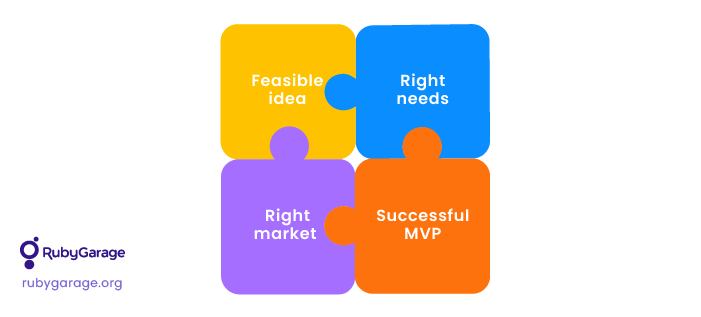
- Your idea is feasible. You’re sure you can create it technically, economically, and legally.
- You address the right needs. You’ve found the problems your users have and the goals they want to achieve, and you have the right solution.
- You’re targeting the right market. You’ve found the right market segment for your product that can provide you with the expected revenue.
- Your MVP succeeded. You’ve launched an MVP and got the expected results.
You can perform product validation activities with a limited number of in-house team members. But for faster and more precise results (and greater convenience), engage a team of experienced professionals.
FAQ
-
Product validation is the process of identifying and addressing existing and potential risks of product development. This requires thorough research to prove your assumptions with data.
-
To validate your product and ensure it has demand, you need to research your target audience, work through all the risks, and test your product as thoroughly as possible. An MVP can help you check how your users interact with your product. Still, you should implement an MVP only after gaining all possible data and ensuring your idea is viable.
-
Without validation, each product idea is just a hypothesis, so it can fail, causing time and monetary losses. By performing product validation, you ensure that your product meets market needs, offers something valuable, and fulfills your business goals. Also, you might gain valuable insights during this process that will make your product even more helpful for customers and more profitable for you.



